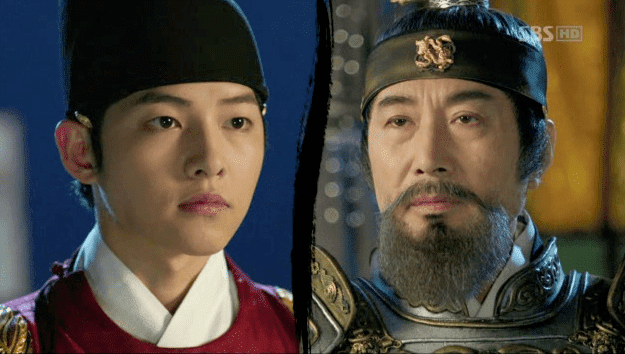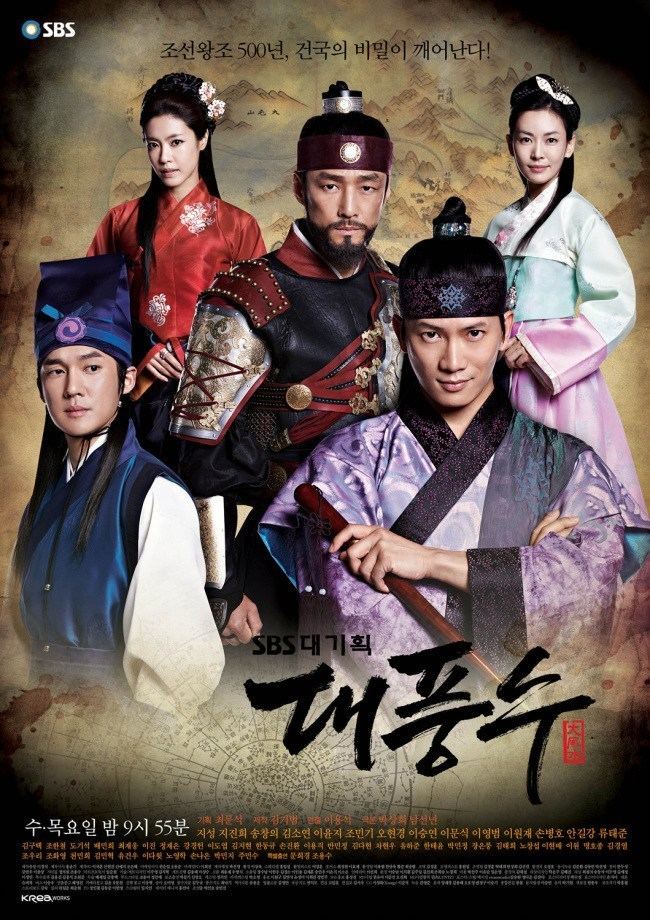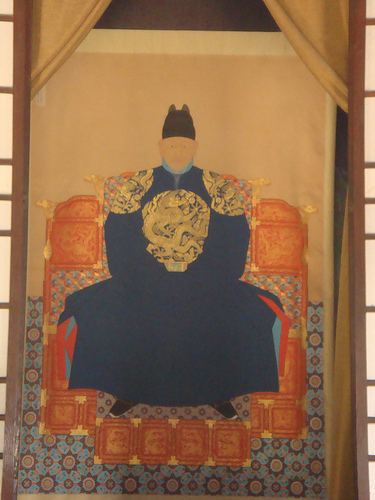Coronation August 5, 1392 Role King Parents Yi Jachun, Queen Euihye | Name Yi Seong-gye Siblings Prince Ui'an-daegun | |
 | ||
Reign August 5, 1392 – October 14, 1398 Born October 27, 1335Hamheung, Hamgyong, Goryeo ( 1335-10-27 ) Spouse Queen Sin-ui,Queen Sindeok Children Taejong of Joseon, Jeongjong of Joseon, Prince Jinan Similar People | ||
Joseon kingdom
Taejo of Joseon (27 October 1335 – 24 May 1408), born Yi Seong-gye, whose changed name is Yi Dan, was the founder and the first king of the Joseon Dynasty of Korea reigning from 1392 to 1398, and the main figure in overthrowing the Goryeo Dynasty.
Contents
- Joseon kingdom
- Historical context for rise
- Military career
- Revolution
- Reign
- His full posthumous name
- Legacy
- Portrayals in adaptations
- References

Taejo's father Yi Ja-chun was a minor Mongol official, but his ethnicity was Korean. Taejo's mother Queen Uihye was originally Chinese. Taejo joined the Goryeo army and rose through the ranks, seizing the throne in 1392. He abdicated in 1398 during the strife between his sons and died in 1408.

Historical context for rise

By the late 14th century, the 400-year-old Goryeo dynasty established by Wang Geon in 918 was tottering, its foundations collapsing from years of war and de facto occupation by the disintegrating Mongol Empire. The legitimacy of Korea itself was also becoming an increasingly disputed issue within the court, as the ruling House failed not only to govern the kingdom effectively, but was also tarnished by generations of forced intermarriage with members of the Mongol Yuan dynasty imperial family and by rivalry amongst the various Goryeo Dynasty royal family branches (even King U's mother was a known commoner, thus leading to rumors disputing his descent from King Gongmin).
Within the kingdom, influential aristocrats, generals, and even prime ministers struggled for royal favor and vied for domination of the court, resulting in deep divisions among various factions. With the ever-increasing number of raids against Goryeo conducted by Japanese pirates (wakō) and the Red Turbans invasions of Korea, those who came to dominate the royal court were the reformed-minded Sinjin aristocracy and the opposing Gweonmun aristocracy, as well as generals who could actually fight off the foreign threats—namely a talented general named Yi Seong-gye and his rival Choe Yeong. With the rise of the Ming dynasty under a former monk, Zhu Yuanzhang (the Hongwu Emperor), Mongol forces became more vulnerable. By the 1350s Goryeo regained its full independence from the waning Mongol Empire, although Mongol remnants effectively occupied northeastern territories with large garrisons of troops.
Military career

General Yi Seong-gye had gained power and respect during the late 1370s and early 1380s by pushing Mongol remnants off the peninsula and also by repelling well-organized Japanese pirates in a series of successful engagements. He was also credited with routing the Red Turbans when they made their move into the Korean Peninsula as part of their rebellion against the Yuan Dynasty. Following in the wake of the rise of the Ming dynasty under Zhu Yuanzhang, the royal court in Goryeo split into two competing factions: the group led by General Yi (supporting the Ming Dynasty) and the camp led by his rival General Choe (supporting the Yuan Dynasty).
When a Ming messenger came to Goryeo in 1388 (the 14th year of King U) to demand the return of a significant portion of Goryeo’s northern territory, General Choe seized the opportunity and played upon the prevailing anti-Ming atmosphere to argue for the invasion of the Liaodong Peninsula (Goryeo claimed to be the successor of the ancient kingdom of Goguryeo; as such, restoring Manchuria as part of Korean territory was a tenet of its foreign policy throughout its history).
A staunchly opposed Yi was chosen to lead the invasion; however, at Wihwa Island on the Amrok River, he made a momentous decision, commonly called "Turning back the army from Wihwa Island", that would alter the course of Korean history. Knowing of the support he enjoyed both from high-ranking government officials, the general populace, and the great deterrent of Ming Empire under the Hongwu Emperor, he decided to revolt and swept back to the capital, Gaesong, to secure control of the government.
Revolution
General Yi swept his army from the Yalu River straight into the capital, defeated forces loyal to the king (led by General Choe, whom he proceeded to eliminate) and forcibly dethroned King U in a de facto coup d'état but did not ascend to the throne right away. Instead, he placed on the throne King U's son, King Chang, and following a failed restoration of the former monarch, had both of them put to death. General Yi, now the undisputed power behind the throne, soon forcibly had a Goryeo royal named Yo, now King Gongyang (공양왕; 恭讓王), crowned as king. After indirectly enforcing his grasp on the royal court through the puppet king, Yi then proceeded to ally himself with Sinjin aristocrats such as Jeong Do-jeon and Jo Jun. In 1392 (the 4th year of King Gongyang), Yi dethroned King Gongyang, exiled him to Wonju (where he and his family were secretly murdered), and ascended the throne. The Goryeo Dynasty had come to an end after 475 years of rule.
One of the most widely repeated episodes that occurred in the immediate aftermath of the fall of Goryeo was in 1392, when Taejo's fifth son, Yi Bang-won (later King Taejong), threw a party for the renowned scholar, poet and statesman Jeong Mong-ju, who refused to be won over by Yi despite their numerous correspondences in the form of archaic poems, and continued to be a faithful supporter of the old dynasty, and a leading figure in the opposition to Yi's claim to the throne. Jeong was revered throughout Goryeo, even by Yi Bang-won himself, but he was seen to be an obstacle and as such, in the eyes of supporters of the new dynasty, had to be removed. After the party, on his way home, Jeong was murdered by five men on the Seonjuk Bridge (선죽교; 善竹橋) in Gaeseong. This bridge has now become a national monument of North Korea, and a brown spot on one of the stones is said to be a bloodstain of his which turns red when it rains.
Reign
Yi Seong-gye declared a new dynasty in 1392–1393 under the name of Joseon, thereby reviving an older state, also known as Joseon, that was, legendarily, established nearly three thousand years previously, and renamed the country the "Kingdom of Great Joseon".
An early achievement of the new monarch was improved relations with China; and indeed, Joseon had its origin in General Yi's refusal to attack China in response to raids from Chinese bandits. Shortly after his accession, the new monarch sent envoys to inform the Ming court at Nanjing that a dynastic change had taken place. Korean envoys were dispatched to Japan, seeking the re-establishment of amicable relations. The mission was successful; and Shogun Ashikaga Yoshimitsu was reported to have been favorably impressed by this initial embassy. Envoys from the Ryūkyū Kingdom were received in 1392, 1394 and 1397. Siam sent an envoy in 1393.
In 1394, the capital was established at Hanseong (Seoul). When the new dynasty was promulgated and officially brought into existence, Taejo brought up the issue of which son would be his successor. Although Taejo's fifth son by Queen Sineui, Yi Bang-won, had contributed most to assisting his father's rise to power, he harbored a profound hatred against two of his father's key allies in the court, the prime minister Jeong Do-jeon and Nam Eun.
Both sides were fully aware of the mutual animosity that existed between each other and constantly felt threatened. When it became clear that Yi Bang-won was the most worthy successor to the throne, Jeong Do-jeon used his influence on the king to convince him that the wisest choice would be in the son that Taejo loved most, not the son that Taejo felt was best for the kingdom.
In 1392, the eighth son of King Taejo (the second son of Queen Sindeok), Grand Prince Uian (Yi Bang-seok) was appointed Prince Royal, or successor to the throne. After the sudden death of the queen, and while King Taejo was still in mourning for his second wife, Jeong Do-jeon conspired to pre-emptively kill Yi Bang-won and his brothers to secure his position in court.
In 1398, upon hearing of this plan, Yi Bang-won immediately revolted and raided the palace, killing Jeong Do-jeon, his followers, and the two sons of the late Queen Sindeok. This incident became known as the First Strife of Princes. Aghast at the fact that his sons were willing to kill each other for the crown, and psychologically exhausted from the death of his second wife, King Taejo immediately crowned his second son Yi Bang-gwa, later King Jeongjong, as the new ruler. Thereafter, King Taejo retired to the Hamhung Royal Villa.
In 1400, King Jeongjong invested his brother Yi Bang-won as heir presumptive and voluntarily abdicated. That same year, Yi Bang-won assumed the throne of Joseon at long last as King Taejong.
Ten years after his abdication, King Taejo died on May 24, 1408 in Changdeok Palace. He was buried at the tomb of Geonwonneung (건원릉, 健元陵) in the city of Guri.
- Queen Shinui of the Anbyeon Han clan (September 1337 – 21 October 1391) (신의왕후 한씨)
- Yi Bang-U, Grand Prince Jinan (1354 - 15 January 1394) (이방우 진안대군)
- Yi Bang-Gwa, Grand Prince Yeongan (18 July 1357 – 15 October 1419) (이방과 영안대군)
- Yi Bang-Ui, Grand Prince Ikan (1360 – 26 September 1404) (이방의 익안대군)
- Yi Bang-Gan, Grand Prince Hwoean (2 July 1364 – 10 April 1421) (이방간 회안대군)
- Yi Bang-Won, Grand Prince Jeongan (13 June 1367 – 30 May 1422) (이방원 정안대군)
- Yi Bang-Yeon, Grand Prince Deokan (이방연 덕안대군)
- Princess Gyeongshin (? – 29 April 1426) (경신공주)
- Princess Gyeongseon (경선공주)
- Queen Sindeok of the Goksan Kang clan (12 July 1356 – 15 September 1396) (신덕왕후 강씨)
- Yi Bang-Beon, Grand Prince Muan (1381 - 6 October 1398) (이방번 무안대군))
- Yi Bang-Seok, Grand Prince Uian (1382 – 6 October 1398) (이방석 의안대군)
- Princess Gyeongsun (? – 8 September 1407) (경순공주)
- Royal Noble Consort Seong of the Wonju Won clan (? – 29 December 1449) (성비 원씨)
- Lady Jeonggyeong of the Goheung Yu clan (정경궁주 유씨)
- Princess Hwaui of the Kim clan (? – 1428) (화의옹주 김씨)
- Princess Sukshin (? – 1453) (숙신옹주)
- Lady Chandeok of the Ju clan (찬덕 주씨)
- Princess Uiryeong (? – 1 February 1466) (의령옹주)
His full posthumous name
Legacy
The tomb of his Umbilical cord is in Man-In-san, Geumsan-gun, South Chungcheong Province in the Republic of Korea.
Despite the fact that he overthrew the kingdom of Goryeo, and purged officials who remained loyal to the old regime, many regard him as a revolutionary and a decisive ruler who deposed the inept, obsolete and crippled governing system to save the nation from many foreign forces and conflicts.
Safeguarding domestic security led the Koreans to rebuild and further discover their culture. In the midst of the rival Yuan and Ming Dynasties, the Joseon Dynasty encouraged the development of national identity which once was threatened by the Mongols. However, some scholars, particularly in North Korea, view him as a mere traitor to the old regime, paralleling him to a bourgeois apostate, and General Choe Yeong as a military elite, who conservatively served the old regime of Goryeo to death.
His diplomatic policy successes in securing Korea in the early modern period is notable.
